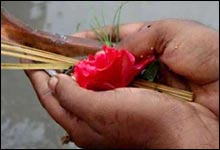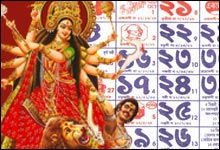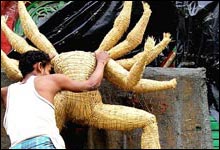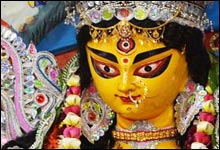Behind the Durga Puja Celebration

DHAKI
His passion and spirit took him to the Indo-Soviet festival in Russia during the tenure of late Prime Minister Rajiv Gandhi. This zealous man of seventy-eight is non other than Jogen dhaki, who has been to different parts of the country and abroad with the captivating beats of dhak and plays for the goddess in Puja mandaps and enchants the people around with his scintillating performance at aprice of 4,000 to 5,000 for the four days of the festival. The spirited man speaking toBangalinet said, " Playing dhak has been my childhood wish and performing it for the Mother Goddess has always been my passion."
BRASS BANDS
An almost mandatory accompaniment for all the festive processions in the city, the brass bands are fast losing their ground. Mehboob Band, the brass band company is one of the earliest ‘Tasha Parties’ of Kolkata. Their glittering dresses, swift movements and music of the percussion instruments form a part of the immersionprocession on the last day of the Durga Puja. Band Master Pran Chandra Udhas on the eve of Durga Puja
said, “ We consider the occasion of Durga Puja the start of our season. We accompany almost all the known Barowari Pujas of Kolkata. In great demand on the Dashami day, we charge around Rs. 4,000for two hours of performance.”The clarinets, cymbals and drums accompanied with organ music mark the farewell
of the Goddess on the dusky evening of Dashami reminding us of the end of the four day long celebrations.
SAARI SHOP
Gariahat, the busy shopping mall of South Calcutta is the most frequented place during the Pujas. For almost forty years Trader’s Assembly, the well-known saari shop, at the juncture of Rashbehari Avenue and Gariahat road has been catering to women.Tapan Saha, the manager of Trader’s Assembly predicts, “ This year, saaries designed with fabric paint should be the new craze but itwill not have any impact on the ever favourite market of pure silk printed saaris. Durga Puja is the time we handle the majority of our business. Financially it is the best time of the year. This is Puja for us.”

DESIGNER CLOTHES
Vesh, a boutique with a difference in just 6 years has created quite a sensation in the arena of new age fashion in Kolkata. A house of exclusive designer garments, Vesh specializes in garments for both men and women. An exclusive range of Salwar Kameezes and printed sarees and Kurtas, all of excellent taste awaits the buyers. The puja specials this year are the dress materials designed with fabric paint along with dresses.
PUBLISHING HOUSE OF POPULAR PUJA MAGAZINES
Puja Barshikis are special editions of popular magazines published during the Puja. The Bengalis, fond of literature flock to the shops to get these special editions. These editions are all time favourites among children too. Among all the Puja Barshikis, “Sondesh” holds a distinct place in the hearts of the people of Bengal. First published in the year 1913 by Upendra Kishore RayChoudhury, suffered a setback after his demise. But in 1961, Satyajit Ray took up the work and the 1st issue of Puja Barshiki was published then. This is the 41st issue of Sondesh Puja Barshiki’s publication. Amitananda Das, the current publisher of Sondesh is the son of the late editor Nalini Das. He says, “Books are an integral part of Bengali psychology.Well-known writers and poets give out their best works during this time of the year. 1/6th of the total yearly sale of books are through the sale of Puja Barshikis. Financially, Puja Barshikis are profitable and of course there is the literary value too. Puja for me is the meeting of the deadline and publishing the best works.”
A TEN-YEAR-OLD GIRL
Kamalika Sarkar, a ten-year-old girl (2001) is pretty excited that the pujas are coming. " Puja means a lot of fun. We'll be pandal hopping all over Kolkata. Then there are also other kinds of fun as there will be a month long holiday. Reading comics and playing games with friends without being bothered are the best things".
SINGER COMPOSING SONGS FOR THE PUJA
Haimonti Shukla is a household name in the Bengali world of music. Trained by her father, Pundit Harihar Shukla, Haimonti mastered both Indian Classical and Bangla Adhuniks. Her tireless contribution to the Bengali audience for the last three decades has placed her in the Bengali heart. Durga Puja is for her a time to welcome new things. She remains busy before the pujas with the recording of her new songs. About her Puja records she says, “I don’t see any difference in the songs sung uring puja and other times. I try to sing every song perfectly. People who listen to my songs can tell better. But the puja records are something special to me. I’ll surely be disheartened if none of my records come out during the puja.” Durga puja is the biggest and the best of all Bengali festivals and she tries to spend it accordingly. This year after a long time she will be spending the Puja in Kolkata. “For the past few years I had to stay out of India but this year is certainly going to be different. I want to spend the puja by meeting friends and close ones and of course by singing.”
WRITER CONTRIBUTING HIS WORKS IN PUJA BARSHIKIS
Dibyendu Palit is a well-known professional writer of Bengali literature. For him, Durga Puja is the biggest Bengali festival without which Bengali life would have been quiet, gray and dull. He contributes his works in Puja Barshikis but as he chooses to write not more than one or two stories, there is not much of a pressure. Speaking to Bangalinet about the difference between regular writing and writing for puja barshikis he says, “I sincerely try to maintain the proper standards in all my works. I do not make any differences. But what I’ve been observing for quite sometime is that Bengali literature has become dependant on Puja Barshikis. Seventy percent of the works that are published as books later appears in the Puja Barshikis.” Puja for him is staying at home and participating in the celebrations in his apartment complex. Aptly describing his activity then he says, “What I really do is meet people who are busy on other times. “Adda” may be the right word to describe my activity during the puja.”



